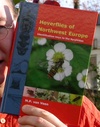Determination keys and field guides
Field guides
Field guides are destined to the more experienced observers. They list all species with a summary of diagnostic characters to separate them from similar species. The more common characters are ommited. Most of the species are illustrated with a photograph.
 |
The grasshopper and crickets field guide overviews all species of the Netherlands and Belgium. It adds several more southern species too, which may extend northwards due to global warming of the planet. Only a Dutch version. |
 |
Keys and provisional keys
The keys allow specimens to be name by providing two alternative description at a time. By selecting the proper description and proceeding to the next, the right species will be found (if you selected all the right descriptions).
 |
Thick headed flies (Diptera: Conopidae). Thick headed flies or Conopid flies are frequent visitors of flowers. Their larvae develop in the abdomen of aculeate Hymenoptera. The female flies onto a host in full flight and deposits an egg between the abdominal segments into the body. Key in English for the Benelux and Great-Brittain. |
 |
Hoverflies of Northwest Europe
 |
Addendum for the book "Hoverflies of Northwest Europe. The addendum includes species that have been described or added to the fauna after the book was published. Typos are also corrected. |
 |



